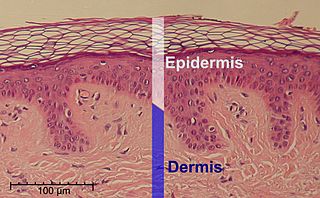Related Research Articles

Apoptosis is a form of programmed cell death that occurs in multicellular organisms and in some eukaryotic, single-celled microorganisms such as yeast. Biochemical events lead to characteristic cell changes (morphology) and death. These changes include blebbing, cell shrinkage, nuclear fragmentation, chromatin condensation, DNA fragmentation, and mRNA decay. The average adult human loses 50 to 70 billion cells each day due to apoptosis. For the average human child between 8 and 14 years old, each day the approximate loss is 20 to 30 billion cells.

Ultraviolet radiation, also known as simply UV, is electromagnetic radiation of wavelengths of 10–400 nanometers, shorter than that of visible light, but longer than X-rays. UV radiation is present in sunlight, and constitutes about 10% of the total electromagnetic radiation output from the Sun. It is also produced by electric arcs, Cherenkov radiation, and specialized lights, such as mercury-vapor lamps, tanning lamps, and black lights.

Necrosis is a form of cell injury which results in the premature death of cells in living tissue by autolysis. The term "necrosis" came about in the mid-19th century and is commonly attributed to German pathologist Rudolf Virchow, who is often regarded as one of the founders of modern pathology. Necrosis is caused by factors external to the cell or tissue, such as infection, or trauma which result in the unregulated digestion of cell components. In contrast, apoptosis is a naturally occurring programmed and targeted cause of cellular death. While apoptosis often provides beneficial effects to the organism, necrosis is almost always detrimental and can be fatal.

Melanocytes are melanin-producing neural crest-derived cells located in the bottom layer of the skin's epidermis, the middle layer of the eye, the inner ear, vaginal epithelium, meninges, bones, and heart found in many mammals and birds. Melanin is a dark pigment primarily responsible for skin color. Once synthesized, melanin is contained in special organelles called melanosomes which can be transported to nearby keratinocytes to induce pigmentation. Thus darker skin tones have more melanosomes present than lighter skin tones. Functionally, melanin serves as protection against UV radiation. Melanocytes also have a role in the immune system.

Skin cancers are cancers that arise from the skin. They are due to the development of abnormal cells that have the ability to invade or spread to other parts of the body. It occurs when skin cells grow uncontrollably, forming malignant tumors. The primary cause of skin cancer is prolonged exposure to ultraviolet (UV) radiation from the sun or tanning devices. Skin cancer is the most commonly diagnosed form of cancer in humans. There are three main types of skin cancers: basal-cell skin cancer (BCC), squamous-cell skin cancer (SCC) and melanoma. The first two, along with a number of less common skin cancers, are known as nonmelanoma skin cancer (NMSC). Basal-cell cancer grows slowly and can damage the tissue around it but is unlikely to spread to distant areas or result in death. It often appears as a painless raised area of skin that may be shiny with small blood vessels running over it or may present as a raised area with an ulcer. Squamous-cell skin cancer is more likely to spread. It usually presents as a hard lump with a scaly top but may also form an ulcer. Melanomas are the most aggressive. Signs include a mole that has changed in size, shape, color, has irregular edges, has more than one color, is itchy or bleeds.

Keratinocytes are the primary type of cell found in the epidermis, the outermost layer of the skin. In humans, they constitute 90% of epidermal skin cells. Basal cells in the basal layer of the skin are sometimes referred to as basal keratinocytes. Keratinocytes form a barrier against environmental damage by heat, UV radiation, water loss, pathogenic bacteria, fungi, parasites, and viruses. A number of structural proteins, enzymes, lipids, and antimicrobial peptides contribute to maintain the important barrier function of the skin. Keratinocytes differentiate from epidermal stem cells in the lower part of the epidermis and migrate towards the surface, finally becoming corneocytes and eventually being shed, which happens every 40 to 56 days in humans.

The epidermis is the outermost of the three layers that comprise the skin, the inner layers being the dermis and hypodermis. The epidermis layer provides a barrier to infection from environmental pathogens and regulates the amount of water released from the body into the atmosphere through transepidermal water loss.

Sun tanning or tanning is the process whereby skin color is darkened or tanned. It is most often a result of exposure to ultraviolet (UV) radiation from sunlight or from artificial sources, such as a tanning lamp found in indoor tanning beds. People who deliberately tan their skin by exposure to the sun engage in a passive recreational activity of sun bathing. Some people use chemical products that can produce a tanning effect without exposure to ultraviolet radiation, known as sunless tanning.

In chemistry and biology, reactive oxygen species (ROS) are highly reactive chemicals formed from diatomic oxygen (O2), water, and hydrogen peroxide. Some prominent ROS are hydroperoxide (O2H), superoxide (O2-), hydroxyl radical (OH.), and singlet oxygen. ROS are pervasive because they are readily produced from O2, which is abundant. ROS are important in many ways, both beneficial and otherwise. ROS function as signals, that turn on and off biological functions. They are intermediates in the redox behavior of O2, which is central to fuel cells. ROS are central to the photodegradation of organic pollutants in the atmosphere. Most often however, ROS are discussed in a biological context, ranging from their effects on aging and their role in causing dangerous genetic mutations.

Karyorrhexis is the destructive fragmentation of the nucleus of a dying cell whereby its chromatin is distributed irregularly throughout the cytoplasm. It is usually preceded by pyknosis and can occur as a result of either programmed cell death (apoptosis), cellular senescence, or necrosis.

Cell death is the event of a biological cell ceasing to carry out its functions. This may be the result of the natural process of old cells dying and being replaced by new ones, as in programmed cell death, or may result from factors such as diseases, localized injury, or the death of the organism of which the cells are part. Apoptosis or Type I cell-death, and autophagy or Type II cell-death are both forms of programmed cell death, while necrosis is a non-physiological process that occurs as a result of infection or injury.
Cell damage is a variety of changes of stress that a cell suffers due to external as well as internal environmental changes. Amongst other causes, this can be due to physical, chemical, infectious, biological, nutritional or immunological factors. Cell damage can be reversible or irreversible. Depending on the extent of injury, the cellular response may be adaptive and where possible, homeostasis is restored. Cell death occurs when the severity of the injury exceeds the cell's ability to repair itself. Cell death is relative to both the length of exposure to a harmful stimulus and the severity of the damage caused. Cell death may occur by necrosis or apoptosis.

Caspase 14 is an enzyme that in humans is encoded by the CASP14 gene. Orthologs of this gene also exist in other mammals, such as sirenians and cetaceans, though they are inactivated in these two clades. Curiously, manatees, which are sirenians, retain some functional CASP14 genes.

Sunburn is a form of radiation burn that affects living tissue, such as skin, that results from an overexposure to ultraviolet (UV) radiation, usually from the Sun. Common symptoms in humans and other animals include red or reddish skin that is hot to the touch or painful, general fatigue, and mild dizziness. Other symptoms include blistering, peeling skin, swelling, itching, and nausea. Excessive UV radiation is the leading cause of (primarily) non-malignant skin tumors, which in extreme cases can be life-threatening. Sunburn is an inflammatory response in the tissue triggered by direct DNA damage by UV radiation. When the cells' DNA is overly damaged by UV radiation, type I cell-death is triggered and the tissue is replaced.

Photoaging or photoageing is a term used for the characteristic changes to skin induced by chronic UVA and UVB exposure. Tretinoin is the best studied retinoid in the treatment of photoaging.
Skin sloughing is the process of shedding dead surface cells from the skin. It is most associated with cosmetic skin maintenance via exfoliation, but can also occur biologically or for medical reasons.
Safingol is a lyso-sphingolipid protein kinase inhibitor. It has the molecular formula C18H39NO2 and is a colorless solid. Medicinally, safingol has demonstrated promising anticancer potential as a modulator of multi-drug resistance and as an inducer of necrosis. The administration of safingol alone has not been shown to exert a significant effect on tumor cell growth. However, preclinical and clinical studies have shown that combining safingol with conventional chemotherapy agents such as fenretinide, vinblastine, irinotecan and mitomycin C can dramatically potentiate their antitumor effects. In phase I clinical trials, it was found to be safe to co-administer with cisplatin, but caused reversible dose-dependent hepatotoxicity.
Immunogenic cell death is any type of cell death eliciting an immune response. Both accidental cell death and regulated cell death can result in immune response. Immunogenic cell death contrasts to forms of cell death that do not elicit any response or even mediate immune tolerance.

TPEN (N,N,N′,N′-tetrakis(2-pyridinylmethyl)-1,2-ethanediamine) is an intracellular membrane-permeable ion chelator. TPEN has a high affinity for many transition metals and should not be considered specific or selective for a particular ion. Chelators can be used in chelation therapy to remove toxic metals in the body. TPEN is a chelator that has a high affinity for zinc. For example, one study showed that TPEN is a stronger chelator compared to other chelators like pentetic acid (DTPA) when high levels of zinc are present (15 μM). When low levels of zinc were present however (0, 3, 6, 9 and 12 μM zinc), there was no significant difference. TPEN is a hexadentate ligand which also forms complexes with other soft metal ions such as Cd2+.

Rhododendrol (RD) also called 4-[(3R)-3-hydroxybutyl]phenol (systemic name), is an organic compound with the formula C10H14O2. It is a naturally occurring ingredient present in many plants, such as the Rhododendron. The phenolic compound was first developed in 2010 as a tyrosinase inhibitor for skin-lightening cosmetics. In 2013, after rhododendrol reportedly caused skin depigmentation in consumers using RD-containing skin-brightening cosmetics, the cosmetics were withdrawn from the market. The skin condition, caused by RD, is called RD-induced leukoderma. Rhododendrol exerts melanocyte cytotoxicity via a tyrosinase-dependent mechanism. It has been shown to impair the normal proliferation of melanocytes through reactive oxygen species-dependent activation of GADD45. It is now well established that rhododendrol is a potent tyrosinase inhibitor.
References
- ↑ Schwarz, A; Bhardwaj R; Aragane Y; Mahnke K; Riemann H; Metze D; Luger TA; Schwarz T (June 1995). "Ultraviolet-B-Induced Apoptosis of Keratinocytes: Evidence for partial involvement of tumor necrosis factor alpha in the formation of sunburn cells". The Society for Investigative Dermatology. 104 (6): 922–927. doi:10.1111/1523-1747.ep12606202.
- ↑ Free Radical Biology and Medicine, Vol 52, Issue 6, 15 March 2012, Pages 1111-1120. Skin mild hypoxia enhances killing of UVB-damaged keratinocytes through relative oxygen species-mediated apoptosis requiring Nova and Bim. Kris Kys, Hannaelore Maes, Graieia Andrei, Rober Snoeck, Maria Garmyn, Partiizia Agostinis
- ↑ Danno, K; Horio, T (1987). "Sunburn cell: factors involved in its formation". Photochem Photobiol. 45: 683–690. doi:10.1111/j.1751-1097.1987.tb07401.x.
- ↑ Young, AR (1987). "The sunburn cell". Photodermatology. 4: 127–134.
- ↑ Carswell EA, Old LJ, Kassel RL, Green S, Fiore N, Williamson B (1975). "An endotoxin-induced serum factor that causes necrosis of tumors". Proc Natl Acad Sci USA. 72: 3666–3670. doi:10.1073/pnas.72.9.3666. PMC 433057 . PMID 1103152.
- ↑ Experimental Eye Research, Vol 93, Issue 5, November 2011, pages 735-740. Stratified Corneal timbal epithelial cells are protected from UVB-induced apoptosis by elevated extracellular potassium ions. Mark Schotanus, Leah R. Koetje, Rachel E. Van Dyken, John L. Ubels
- ↑ Methods 2008; 44; pages 205-221, Apoptosis and necrosis, detection, discrimination and phagocytosis, Krysko D.V. Berghe T.V. D. Herde, K., Vandenabeele P.
- ↑ Zhang, W; Hanks A; Boucher K; Florell S; Allen S; Alexndar A; Brash D; Grossman D (2005). "UVB-Induced Apoptosis drives clonal expansion during skin tumor development". Carcinogenesis. 26: 249–257. doi:10.1093/carcin/bgh300. PMC 2292404 . PMID 15498793.
- ↑ Pedeux, R.; Sengupta S; Shen JC; et al. (2006). "ING2 Regulates the onset of replicative senescence by induction of p300 dependent p53 acetylation". Mol. Cell. Biol. 25: 6639–48. doi:10.1128/MCB.25.15.6639-6648.2005. PMC 1190357 . PMID 16024799.
- Free Radical Biology and Medicine, Vol 52, Issue 6, 15 March 2012, Pages 1111-1120. Skin mild hypoxia enhances killing of UVB-damaged keratinocytes through relative oxygen species-mediated apoptosis requiring Nova and Bim. Kris Kys, Hannaelore Maes, Graieia Andrei, Rober Snoeck, Maria Garmyn, Partiizia Agostinis
- Experimental Eye Research, Vol 93, Issue 5, November 2011, pages 735-740. Stratified Corneal timbal epithelial cells are protected from UVB-induced apoptosis by elevated extracellular potassium ions. Mark Schotanus, Leah R. Koetje, Rachel E. Van Dyken, John L. Ubels
- Methods 2008; 44; pages 205-221, Apoptosis and necrosis, detection, discrimination and phagocytosis, Krysko D.V. Berghe T.V. D. Herde, K., Vandenabeele P